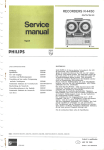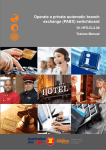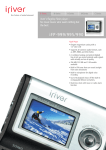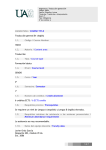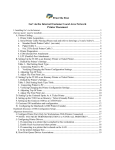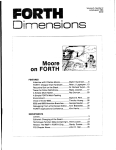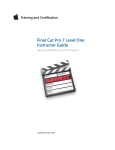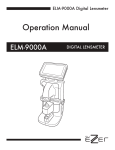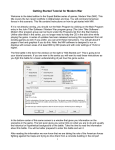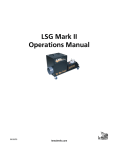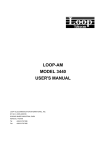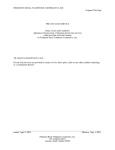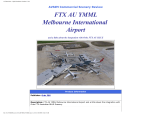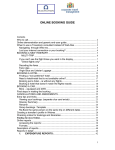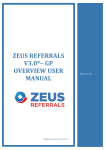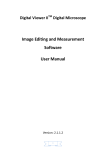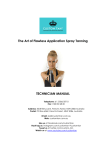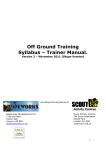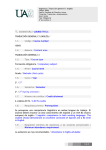Download topic 1 - TVET Events
Transcript
Tourism Hospitality and Events Training Package SIT07 SITXADM001A Perform office procedures Release date: February 2012. Version1. © TAFE NSW 2012 i SITXADM001A Perform office procedures TABLE OF CONTENTS INTRODUCTION ............................................................................................................... 1 RESOURCE OVERVIEW ........................................................................................................ 1 REQUIRED SKILLS AND KNOWLEDGE .................................................................................. 1 • COMPLETION OF OFFICE ADMINISTRATIVE ACTIVITIES WITHIN TYPICAL WORKPLACE TIME CONSTRAINTS.REQUIRED ELEMENTS AND PERFORMANCE CRITERIA .......................... 1 • REQUIRED ELEMENTS AND PERFORMANCE CRITERIA .................................................. 2 TOPIC 1 – TOURISM OFFICE DOCUMENTS ............................................................. 5 CLIENT FILES ...................................................................................................................... 7 BOOKING FILES ................................................................................................................ 10 SENIOR TRAVEL CONSULTANT ......................................................................................... 12 TOPIC 2 – THE EFFECTIVE USE OF OFFICE DOCUMENTS .............................. 17 TYPES OF WRITTEN COMMUNICATION .............................................................................. 17 PAPERWORK FOR YOUR CLIENT'S BOOKINGS .................................................................... 23 FINANCIAL DOCUMENTS ................................................................................................... 30 RECEIPT ........................................................................................................................... 32 OTHER DOCUMENTATION ................................................................................................. 36 TOPIC 3 – PROCESSING OFFICE DOCUMENTS .................................................... 46 MAINTAINING A GOOD FILING SYSTEM ............................................................................. 46 TOPIC 4 – OPERATING OFFICE EQUIPMENT ....................................................... 54 SPECIFIC FUNCTIONS AND FEATURES OF EQUIPMENT ........................................................ 54 EQUIPMENT MAINTENANCE AND CARE ............................................................................. 57 SUMMING UP .................................................................................................................. 64 ii © TAFE NSW 2012 INTRODUCTION Welcome to the resource SITXADM001A, Perform Office Procedures. This resource describes a fundamental administrative function for the tourism and hospitality industries and applies to the full range of industry sectors and environments. All manner of personnel are required to perform office procedures. For some it may be a key aspect of their job (e.g. for those working in an office environment) and for others an occasional task (e.g. for those working in a stock control environment or kitchen). Resource overview This unit describes the performance outcomes, skills and knowledge required to complete a range of routine office procedures and activities, including writing simple correspondence. Required skills and knowledge The following skills are required to complete this unit: • communication skills to convey meaning clearly and concisely • basic literacy and written communication skills to produce workplace documentation and correspondence • basic numeracy skills to do simple clerical tasks and count. The following knowledge must be assessed as part of this unit: • organisation practices and procedures for preparing and processing documents • layout, format and features of typical business documents and alternative formats for special needs groups, such as large print • features and usage of typical office equipment • safe work practices for using office equipment and any related chemicals. To prove competence in this unit evidence of the following is essential: • ability to draft multiple pieces of clear, concise and correct written communication, with different purposes, appropriate to the audience and situation • ability to process a range of office documentation accurately and undertake a range of office tasks using different equipment ideally across a complete shift or operating period to address a range of office tasks • completion of office administrative activities within typical workplace time constraints. © TAFE NSW 2012 1 Required elements and performance criteria ELEMENTS 1. Process office documents. 2. Draft written communication. 3. Maintain document systems. 2 PERFORMANCE CRITERIA 1.1 Process office documents according to organisation procedures and within designated timelines. 1.2 Use office equipment safely and correctly to process documents. 1.3 Identify, rectify or report office equipment malfunctions promptly and according to organisation procedures. 2.1 Select appropriate format and style for correspondence according to purpose, audience and situation. 2.2 Draft documents according to organisation formats and protocols. 2.3 Use clear and concise language appropriate to purpose, audience and situation. 2.4 Use correct spelling, punctuation and grammar to ensure understanding by receiver. 2.5 Check information for accuracy prior to sending. 3.1 File or store documents according to organisation security procedures. 3.2 Modify and update reference and index systems according to organisation procedures. © TAFE NSW 2012 Suggested learning resources Harris R & Howard J 2001, The Australian Travel Agency. McGraw Hill: Sydney. O’Shannessy V, Minett, D & Hyde, G (2007), The Road to Tourism. Pearson Education: Frenchs Forest, Sydney. © TAFE NSW 2012 3 4 © TAFE NSW 2012 TOPIC 1 – TOURISM OFFICE DOCUMENTS At the end of this topic you should be able to: Identify documentation processed in a tourism office. Every tourism and hospitality office functions use a range of documents. These documents may be general office documents such as receipts, invoices and vouchers that you may have come across in any business. Activity 1.1 1. 2. Think of all the clerical procedures you might perform in a tourism, hospitality or events office and tick the documents from the following list that you think are relevant. client booking files vouchers client file diaries deposit slips faxes to clients order forms letters to clients cheques memos telephone messages emails invitations reports petty cash books receipts stationery order forms financial records itineraries invoices costing sheets quotation forms booking forms Can you think of any other documents not listed above? © TAFE NSW 2012 5 6 © TAFE NSW 2012 Client files Using the relevant documents in the industry is vital for handling client files efficiently. Typically, client files will include: • client profiles • bookings files • file diaries • letters Client profiles Client profiles should record as many client details as possible. These may be required for current and any future reservations. The consultant handling the file will not have to keep asking the customer the same information each time a reservation is made. © TAFE NSW 2012 7 Sample: Client profile Personal details Name: _______________________________________________________ Address: _______________________________________________________ _______________________________________________________ Phone: _______________________________________________________ Mobile: _______________________________________________________ Fax: _______________________________________________________ Email: _______________________________________________________ Nationality: _______________________________________________________ Passport details: _______________________________________________________ Diet requirements: _______________________________________________________ Medication: _______________________________________________________ Accommodation Type of establishment: _______________________________________________________ Location: _______________________________________________________ Room type: _______________________________________________________ Outlook: _______________________________________________________ Rate: _______________________________________________________ Breakfast preference: _______________________________________________________ Smoking: _______________________________________________________ Frequent flyer/airline club membership: _______________________________________________________ Airline 8 © TAFE NSW 2012 Class of travel: _______________________________________________________ Seat preference: _______________________________________________________ Meals: _______________________________________________________ Frequent flyer/airline club membership: _______________________________________________________ Rail Class: _______________________________________________________ Seating: _______________________________________________________ Sleeping: _______________________________________________________ Meals: _______________________________________________________ Cruise Type of cruise: _______________________________________________________ Cabin type: _______________________________________________________ Deck preference: _______________________________________________________ Meal sitting: _______________________________________________________ Vehicle rental Type of car: _______________________________________________________ Preferred operator: _______________________________________________________ Club operator: _______________________________________________________ © TAFE NSW 2012 9 Booking files These are completed to have all the information relevant to each particular reservation. File diaries Any communication or action you make on behalf of a client should be noted in a file diary. A file diary is a record of every discussion, phone call or action, as well as the name of the person or people involved. If relevant, you should include the consultant’s name, the name of the supplier’s consultant and the client. Letters All official letters should use the organisation’s letterhead which shows the company’s name, address and other contact details such as telephone and fax numbers, email address, the ABN and the travel agency’s licence number. The body of the letter should include the following details: • date • name and address of the person or people to whom you are writing • reference details (your file number and the recipient’s file number) • the name, position and signature of the person who is writing the letter Writing business letters Being able to write a polite, clear and concise letter is very important to everyone in business, especially in travel. Remember, you can’t chase a plane down the runway if you’ve forgotten to tell something to a client on the flight! For a good examples of a business letters to a client, read the following: 10 © TAFE NSW 2012 Example A: Travel Options 500 Chapel Road, Sydney NSW 2000 Ph: (61) 02 9123 4567 Fax: (61) 02 9123 4566 email: [email protected] ABN 88 808 668 686 Our reference: JTG721959 1 August 20XX Mr M & Mrs C Stuart 1 Fox Place FOXVILLE NSW 2200 Dear Michael and Cate, Thank you for the opportunity to assist with your proposed trip to Victoria, departing 10 December. We are mindful of your needs and are happy to present the following based on what we have discussed with you. COSTING IS AS FOLLOWS: PACKAGE DEAL: Melbourne Weekend PACKAGE INCLUSIONS: • Return Economy airfares flying Jetstar • Return airport transfers • 7 nights’ accommodation Grand Regency Hotel, Deluxe Room • Full buffet breakfast daily • Day trip to Great Ocean Road $2805.00 TOTAL $ 548.00 $ 85.00 $1852.00 $ 140.00 $ 180.00 The above costs are based on current rates as at quotation date and are subject to availability when booking. All prices are correct at date of issue but will be subject to change until full payment has been received. Travel insurance is highly recommended to protect you against cancellation due to unforeseen circumstances. Please discuss your individual circumstances with us so we can determine the policy to best suit your needs. If you require any further information or clarification on the above, please do not hesitate to contact me. Yours faithfully, LEANNE BLANCHETT © TAFE NSW 2012 11 Senior Travel Consultant 12 © TAFE NSW 2012 Example B: Travel Options 500 Chapel Road, Sydney NSW 2000 Ph: (61) 02 9123 4567 Fax: (61) 02 9123 4566 email: [email protected] ABN 88 808 668 686 9 June 20XX Our reference: WBC110902 Mr G Morton, President The Willows Bushwalking Club 15 Valley Street Sydney NSW 2000 Dear Gerard, Re: Club tour to America I refer to our telephone conversation and have pleasure in attaching our quotation for your club’s tour to America in September this year. Also attached is a detailed costing sheet and booking conditions. Once you have had an opportunity to study all three documents, I would be very happy to meet with you and discuss your tour further. Thank you for asking Lavish Hotel to assist you in this project. Rest assured we shall offer you all the possible assistance to ensure your club members have a happy and memorable tour to America. Yours sincerely, RON WISE Senior Consultant © TAFE NSW 2012 13 Industry staff often needs to communicate in writing with principals, clients and potential clients for a range of reasons. As noted earlier in this chapter, this communication may take one of a number of forms including letters, faxes and email messages. In relation to a particular booking you are likely to receive correspondence from clients and principals, as well as from other suppliers of services related to the booking. Clients might communicate with a consultant to make an inquiry about a particular destination and/or product; to request that a booking be made on their behalf; to forward a deposit, a completed booking form and/or final payment; or to amend or cancel an existing booking. It is standard practice for agencies to record the receipt of such correspondence in a register; payments through a back office system; file diary and/or to keep copies attached to the client file. Although the policies and procedures adopted by businesses differ, it is possible to describe some of the more common circumstances when return correspondence from the consultant to the client may be required and the information that such correspondence might include. Outward correspondence might involve responding to a client inquiry; confirming booking details and costings; acknowledging and confirming amendments and/or cancellations; advising operator-caused amendments; requesting either a deposit or final payment; or forwarding final documentation such as tickets. Types of letters • answering client enquires • confirmation letters • quotation letters • payment request/reminder letters • amendments • departure letters • welcome home letters • responses to complaints. 14 © TAFE NSW 2012 Activity 1.2 Ron has the details of eight (8) club members who have said they will purchase the tour. He has asked Miguel to write a letter to each of these people, requesting a deposit of $300.00 per person. Ron must sign the letters. Miguel must explain that the travel agency has a deadline of 21 days from the date of the letter in which to pay a deposit to the American tour operator. Write the letter you think Miguel should prepare for Ron to sign. © TAFE NSW 2012 15 Check your understanding. Self evaluation questions Topic 1 1. Write a brief description of the functions of the following documents: - client profiles - booking files - file diaries - letters 2. Where and how would you keep the client profile so that you could access the information promptly? 3. You have had practice writing a business letter. Where and how would you file the letter you were asked to write concerning a client? 16 © TAFE NSW 2012 TOPIC 2 – THE EFFECTIVE USE OF OFFICE DOCUMENTS At the end of this topic you should be able to: List and describe the ways in which office documents may need to be processed. List and describe major types of correspondence produced within the tourism industry. Draft documents used by industry. Apart from written communication in the form of letters sent by post, written communication is often done by: • memo • fax • email. Knowing what sort of document to use when sending written correspondence (e.g. memos and faxes) is very important and there are often different formats for each type. Types of written communication Memos The memo must contain the name(s) of the staff member(s) sending the memo, the names(s) of the recipient(s) and those who should receive a copy (in other words, CC), the date, subject and the subject contents. If the person sending the memo works for a large company, then the sender and recipient’s departments should also be noted. © TAFE NSW 2012 17 Sample memo: Lavish Hotel 500 Church Street, Sydney NSW 2000 Ph: (61) 02 9123 4567 Fax: (61) 02 9123 4566 email: [email protected] ABN 88 808 668 686 MEMO To: Miguel Durur From: Ron Woolfe CC: - Date: 12/7/02 Re: THE WILLOW BUSHWALING CLUB Dear Miguel, As I will be out of the office for most of the day, would you please prepare a client information package for the above tour and put it on my desk by 1600 hrs this afternoon. Thank you Regards, Ron Faxes Even though email communication is very common, faxes are still used. Some organisations create pro forma or template faxes for certain types of communications (e.g., reservations, rooming lists). The basic format, however, includes the organisation’s letterhead (indicating the organisation’s name, telephone and fax numbers, email or Web address, ABN and the travel agency’s license number), and the subject matter. Often the subject matter is indicated with ‘Re:’ near the top of the fax. 18 © TAFE NSW 2012 Sample fax: Lavish Hotel 500 Church Street, Sydney NSW 2000 Ph: (61) 02 9123 4567 Fax: (61) 02 9123 4566 email: [email protected] ABN 88 808 668 686 To: Gerard Morton From: Miguel Durur Company: Willows B’walking Club Date: 12/7/08 Fax no.: 02 9111 2222 Total no. pages inc. cover: 1 Phone no.: 02 9111 1111 Sender’s fax no.: 9123 4566 Re: Booking Sender’s phone no.: 02 9553 7296 / 9587 4934 Urgent For review Please comment Please reply Notes/comments Dear Mr Morton I refer to your telephone call today and wish to confirm we have now received the deposit of AUD$1600.00 along with names of your party. Kind regards Miguel Durur © TAFE NSW 2012 19 Activity 2.1 Ron’s client, the Willows Bushwalking Club, has asked him to advise the North American tour operator, Step Ahead Tours, to amend their reservation from three (3) to four (4) days in Yosemite National Park. Ron wants Miguel to send a fax advising of the change and, because it is important and the fax must be accurate, Ron will write out the instructions to Miguel in a memo. Using the Memo and Fax templates provided, you are to: 1. Write the memo Ron writes to Miguel, outlining his instructions. Make sure you identify the writer and the recipient, add a date, show the subject, and ensure that the message is concise and accurate and sign the memo. 20 © TAFE NSW 2012 2. Write a fax that Miguel will send (on Ron’s behalf) to Step Ahead, requesting the amendment. Make sure your fax, has clearly set out details such as: the name of the organisation, contact details, the recipient’s details and a concise message. © TAFE NSW 2012 21 Using email Email is the abbreviation for electronic mail. It is a quick and efficient form of communication. It is also a flexible form of written communication, since you can attach documents, identify the level of priority for the despatch of the email and include a large number of recipients in the email address. Emails are the fastest growing type of written communication. They are used for intraoffice or departmental communication as well as inter-office or departmental/ organisational contacts. Sample email 22 © TAFE NSW 2012 Paperwork for your client's bookings Travel Documents Documents for the client include itineraries, quotation forms, booking forms, confirmation letters and costings. Other documents include tickets, vouchers and exchange orders. Itineraries These are some of the most important documents issued by a tourism organisation. They tell the clients not just what they are going to buy, but when, what time, and also what is expected of them. Itineraries must be well laid out, clear, concise, and also attractive to the reader. Remember, they may represent a ‘dream’ to the client. They should contain some of the following details which are relevant to the booking: • the day and date • origin and destination • transport details including departure and arrival details (including times shown using the 24-hour clock), carrier’s name, class of travel and duration of flight or trip • touring details (e.g. vehicle rental details and accommodation details) • supplier contact details (Note: Check-in times vary. Sydney International Qantas check-in desk opens three hours before departure of the flight). Important points to note when preparing an itinerary: • Provide information in a sequential order. • Always indicate both the day and the date. • Never use industry jargon or codes (without explanation). • Layout should be consistent throughout the entire document. • Accuracy is essential. • Neatness and spelling are important. © TAFE NSW 2012 23 Sample itinerary for travel consultants (There are several types of itineraries. This one is ideal for a travel consultant’s booking file.) Pax names Age Pnr no. Fare type Tktg deadline 1. Ticket 2. Date 3. 4. Home ctc: Flight Class Date Accommodation In From Depart Arrive time Airline/ date res. officer Fare Status Booke d by Date Prepaid Costing A$ Details Tour code Accom type Booked by Deposit/ payment Costing A$ City Via/ status Date Deposit/ payment Rate A$ Return Out Depart time Details Car/coach/rail/sea 24 Status Out Tours In To Details © TAFE NSW 2012 Sample itinerary for clients (This is one concept for presentation of a travel itinerary to a client.) ITINERARY ESPECIALLY PREPARED FOR: MR BRADLEY JONES & MS ANGELINE SMITH DATE OF ISSUE CONSULTANT Today’s Date Your Name 01 Dec XX Check in at Sydney Airport Terminal T3 at least 1 hour prior to your scheduled departure Sat SYDNEY/GOLD COAST QANTAS Flight QF467 Economy Class Depart Arrive 12:05 13:00 Sydney Gold Coast On arrival collected your rental vehicle: Avis Group E Vehicle Auto. Holden Commodore or similar Pick up: 1.30pm Avis Airport desk Please make your own way to your hotel. GOLD COAST ACCOMMODATION Check in Check out 14:00 10:00 SURFERS PARADISE MARRIOTT RESORT 158 Ferny Avenue Surfers Paradise QLD PH: 07 5555 0000 IN: 01 December OUT: 10 December DELUXE QUEEN ROOM WITH SPA 02 Dec XX Sun ISLAND QUEEN SHOWBOAT DINNER CRUISE You will be collected from your hotel by stretch limousine at 6.30pm. At the conclusion you will be transferred back to your hotel, approximately 11.30pm. 03 Dec XX Mon SEAWORLD DAY PASS You have a entry pass only into SeaWorld, please make your own way to the theme park. Opening hours 9.00am –5.00pm free parking 10 Dec XX Mon Please return your rental vehicle to Avis, prior to check in for your flight home. Please check in at least 1 hour prior to your scheduled departure. GOLD COAST /SYDNEY © TAFE NSW 2012 QANTAS Flight QF598 Economy Class 25 Depart Arrive Gold Coast Sydney 11:05 12:30 This is another concept for presentation of a travel itinerary to a client. DAY 01 DATE Mon14 Oct ‘02 HRS 16.00 SERVICE QANTAS CHECK IN Desk opens at Sydney International Airport 19.00 DEPART Sydney on QF65 23.55 ARRIVE Christchurch where you will be met by a guide from Quality Tours and transferred to your hotel by Alpine Coaches. ACCOMMODATION: 1 twin room at the: Happy Valley Hotel, 6 Birch Street ANDELSBEY Tel: (05) 2221 6555 Fax: (05) 2221 6552 Quality Tours: Tel (05) 2321 4111 Alpine Coaches: Tel (05) 2444 1234 (Note how the operative words such as: ‘check in’, ‘depart’, ‘arrive’ are in capitals letters for emphasis.) Quotation forms Quotation forms inform potential clients of the costs of their proposed arrangements including taxes and possible discounts. Booking forms Some wholesalers, tour operators and hotels require these to be completed and then signed by the client. The booking forms serve as a request to the supplier to reserve services at a nominated cost, while at the same time, the client undertakes to adhere to the booking conditions as set out by the supplier. 26 © TAFE NSW 2012 Costing sheets These list the services, costs (including taxes) to the client of each service or, alternatively, the total cost of all services. Confirmation letters Confirmation letters are generally sent to clients once all their bookings and reservations have been confirmed for transport, accommodation, tours and so on. They should contain the following details: • the destination • the date and place of departure • the price per person (and all relevant inclusions) • the deposit and final payment requirements • information about cancellation and amendment fees • any important terms and conditions • information about travel insurance • passport and visa requirements and health requirements and recommendations, if it is an international trip. © TAFE NSW 2012 27 Sample confirmation letter: 07 February 20XX Travel Options 500 Chapel Road, Sydney NSW 2000 Ph: (61) 02 9123 4567 Fax: (61) 02 9123 4566 email: [email protected] ABN 88 808 668 686 Mr Reg Soares Program Manager JBM Enterprises 10 Edwards Place BOTANY NSW 1378 Dear Reg RE: Your holiday to Ireland & Kenya Departing: 22 September 20XX We have pleasure in confirming the reservations for your forthcoming trip to Ireland & Kenya. For full details please see the attached itinerary. The total cost of your holiday is $17,600.00 and is outlined in your Statement of Account. A nonrefundable deposit of $600.00 is due no later than Friday 14 February 20XX, and final payment of $17,000.00 is due in our office on or before Friday 20 July 20XX. Travel Insurance is highly recommended to protect you against unforeseen circumstances. We will review your individual circumstances and recommend an appropriate policy when you pay your deposit. A current Australian passport will be required to undertake this holiday. Visa requirements for Kenya will also be required which we can assist you in obtaining. For information regarding overseas health regulations, we recommend you consult your local doctor or the Traveller’s Medical and Vaccination Centre on (02) 9221 7133. The airfares and tours on which you have been booked are subject to amendment and cancellation fees. These are detailed in the current Explore Tours Ireland & Bench International Africa brochures. Agency fees have been charged in addition to your holiday costs and are detailed in our terms of trade. Your documents should be ready for collection approximately 7 – 10 days prior to your departure. We will contact you upon their arrival to arrange a suitable time for collection. We trust these arrangements are to your satisfaction. However, should you have any queries please do not hesitate to call our office on 9123 4567. Yours sincerely (Your name) (TITLE) Encl: 28 XXXXX © TAFE NSW 2012 Like all the documents you prepare in the travel industry, it’s vital that the documents you produce for clients: • are produced quickly (and within the timeframe you’ve agreed with the client) • are proof-read for correct spelling, punctuation and grammar • are double-checked so that the content is correct and current • meet industry and your business’ requirements. Imagine if you gave a client incorrect details about a flight and they turn up too late, and their entire holiday plan is ruined! Likewise, it’s important to produce documents quickly, especially if a client wishes to take advantage of special offers that have a time limit and that may save them a lot of money. They will not be happy if they miss out on a cheaper ticket because of your delay. Checking the currency of information is also very important, since the agency would have to pay the difference if a client is accidentally undercharged. The travel organisation will use a great number of documents that are not exclusive to travel organisations. They can cover financial documents, general operational documents and others such as reports. © TAFE NSW 2012 29 Financial documents Financial records FEEDBACK ON ACTIVITY 2.2 - Did you include: • invoice to The Willows Bushwalking Club • receipt for the club’s cheque • deposit slip for payment for the club’s cheque into the bank • the travel agency’s cheque to Happy Travel Coach Company? Did you also list all these transactions on the client file’s financial record sheet? These must show both the receipts and payments of a file and also the type of document issued (e.g., an invoice, receipt, cheque). Each time a transaction takes place, it must be recorded on the form used for a client’s financial records. Sample client financial record Date 2002 18 May 20 May Receipt $ 2400.00 21 May 25 May 26 May Payment $ 1600.00 12 000.00 From/to whom Willows Bushwalking Club Willows Bushwalking Club Step Ahead, Walking Tours, Los Angeles Willows 11 200.00 US inc. Airlines For Deposit for payment of initial deposit Deposit agency/ wholesaler Deposit on American tour Invoice no. 6210 Return air fare, 8 persons Payment for air fare for 8 persons Invoices These are raised to obtain payment for goods or services sold. 30 © TAFE NSW 2012 Receipt / chq no. Balance 2400.00 Rec no. 2684 2400.00 Chq no. 4521 800.00 Rec no. 2715 12 800.00 Chq no. 4572 1600.00 An invoice must show: • name, address and contact details of the company raising (i.e. creating) the invoice • the person or organisation to whom the invoice will be sent • the Australian Business Number (ABN) of the organisation raising the invoice • the date the invoice is ‘raised’ and the date of the service rendered • details of the service or goods, the amount payable, whether the Goods and Services Tax (GST) is applicable. Invoices should also show the total amount and, in many cases, bank account details for payment by direct debit. Sample invoice Travel Options 500 Chapel Raod, Sydney NSW 2000 Ph: (61) 02 9123 4567 Fax: (61) 02 9123 4566 email: [email protected] ABN 88 808 668 686 Invoice No. Date: To: 231X 18 May 2008 Mr G Morton The Willows Bushwalking Club 15 Valley Street Sydney NSW 2000 AUSTRALIA Terms of payment: Within 14 days of date of invoice. Date 18 May 02 Quantity 8 passengers Description Initial deposit on tour to America Total amount payable: Rate $300.00 per person Amount $2400.00 $2400.00 Bank account details: Business Bank of Sydney Branch: Sydney NSW © TAFE NSW 2012 31 Receipts Receipts must be issued for all payments made. They should show the date of issue, who made the payment and for what, and the amount. Handwritten receipts normally show the signature of the staff member issuing the receipt. Sample receipt: Travel Options 500 Chapel Road, Sydney NSW 2000 Ph: (61) 02 9123 4567 Fax: (61) 02 9123 4566 email: [email protected] ABN 88 808 668 686 Receipt No: 2684 Issued on: 20th May 2008 By: Miguel Durur For: Payment received of initial deposit from The Willows Bushwalking Club. Amount (in words): Two thousand four hundred dollars $2400.00 (Signature) 32 © TAFE NSW 2012 Deposit slips These must show the name of the drawer (the organisation or person who wrote the cheque), the drawer’s bank details, date, amount of the cheque, number of cheques being deposited (if there are any others) and the signature of the person making the deposit (not necessarily the holder of the account). Deposit slip: Deposit for Account at Business Bank Date Deposit for credit in BUSINESS BANK OF SYDNEY BRANCH: BANKSTOWN Deposit Date (Details of cheques) DRAWER NOTES BANK BRANCH COIN Commission No. of Chq. cheque account of $ (Proceeds of cheques etc will not be available until collected) Teller PAID IN BY (Proceeds of cheques etc will not be available until collected) (Signature) Teller TRAVEL OPTIONS Cheques Cheques must show the person or organisation to whom the cheque is payable, the amount in words and figures, the date and the signature(s) of the person(s) authorised to sign the cheques. In most organisations, two people must sign a cheque as a method of control. No. SPECIMEN BUSINESS BANK OF SYDNEY To SYDNEY 2000 For $ c PAY ________________________________ OR BEARER Balance bt. fwd. Deposits THE SUM Sub total _____________________________________ $ _______________ This cheque Sub total TRAVEL OPTIONS ATM/EFTPOS Balance cd. fwd. “809”326”23””95””138” © TAFE NSW 2012 33 34 © TAFE NSW 2012 Activity 2.2 You have made a booking at your hotel for the Habourside Rotary Club (10 twins and 3 single rooms with breakfast). Each room is $350 per night and breakfast is $29.50 per person and a deposit of $50 per person is received within 10 days of your letter. Which documents would you require to complete these transactions? © TAFE NSW 2012 35 Other documentation In any organisation, there are many clerical activities that are similar to those carried out in other non-travel organisations. These include taking messages and ordering office supplies, and they all need to be documented. This means that, apart from documentation related to booking and payments for services, there are other types of documents that can be found in many other types of businesses. Some of these are described below. Order forms These are commonly called ‘purchase orders’, and should state: • the type of service or goods required • the amount quoted • the supply company’s details • the delivery instructions • the signature of the staff member authorised to make purchases. Sample purchase order Lavish Hotel Purchase order 500 Church Street, Sydney NSW 2000 Ph: (61) 02 9123 4567 Fax: (61) 02 9123 4566 email: [email protected] ABN 88 808 668 686 Date: ____________ Order no: ______________________ Note: All suppliers must possess an ABN and be registered for the GST. To: ______________________________________________________ (Name & address of supplier) Item code no. No. of items Description Cost TOTAL $ Delivery instructions (Date and address) ____________________________________________________________________________ ____________________________________________________________________________ Authorised by (name): ____________________ (Signature): __________________________ 36 © TAFE NSW 2012 Telephone messages Telephone messages can be recorded by email or on a message pad like the one below, and should include the following details: • caller’s name • date and time of the call • whether the caller wants the call returned or will ring back later • level of urgency • occasionally, the subject of the call (e.g., ‘concerning Mr Smith’s reservation’). Remember, when you have completed the form, make sure it is given promptly to the person for whom it is meant. Sample telephone message pad Message To _______________________________________ Date _____________________________________ Time _____________________________________ While you were out… M _______________________________________ of _______________________________________ Phone no ___________ Ext __________________ Telephoned Called to see you Wants to see you Please phone Will call again URGENT Message __________________________________ _________________________________________ _________________________________________ _________________________________________ © TAFE NSW 2012 37 Invitations Invitations can be made for events such as film nights and information sessions. Details on your invitations should show: • the host’s (individual or company) name • the name of the invited guest • the address, date and time of the function • the reason for the function (e.g. film evening) • RSVP details (i.e. the person to whom guests should reply and the telephone number or address to reply to). Sample invitation Lavish Hotel 500 Church Street, Sydney NSW 2000 Ph: (61) 02 9123 4567 Fax: (61) 02 9123 4566 email: [email protected] ABN 88 808 668 686 Invitation LAVISH HOTEL Has pleasure in inviting ______________________________________________________________ to an evening of film and fun! At: The Willows Bushwalking Club 15 Valley Street, Sydney NSW 2000 on Wednesday 12th June 2008 at 7pm. Come and learn about our forthcoming tour of North America – something you have always dreamed of and it’s within your reach! See the beautiful scenery that awaits you and learn about the great program we have created for you. It’s a great opportunity to indulge in your favourite pastime with friends and have fun at the same time. RSVP: Wed. 29th May 2008 Tel: Miguel Durur On: (02) 9123 4567 Stationery request forms These are often raised and added to over a period of time until the order is large enough for special discounts, etc. It is then approved and sent to the suppliers. 38 © TAFE NSW 2012 Sample stationery request form Lavish Hotel 500 Church Street, Sydney NSW 2000 Ph: (61) 02 9123 4567 Fax: (61) 02 9123 4566 email: [email protected] ABN 88 808 668 686 Department: ____________________________________________________________ Requisition officer:_______________________________________________________ Date: __________________________________________________________________ Approving officer: _______________________________________________________ Description Quantity Unit Store item no. Received: ______________________________________________________________ Date: __________________________________________________________________ © TAFE NSW 2012 39 Petty cash vouchers You must accurately complete a voucher with date of issue, amount (often in words and figures), the reason for the expenditure, a receipt should be attached and the staff member making the purchase must sign the voucher. Sample petty cash voucher PETTY CASH VOUCHER Date: Debit (account name: e.g. ‘Stationery’) Amount…………………….. Dollars………………Cents Details $……………= Signature……………………… Should a staff member receive an advance before making a purchase, then it is normal for an ‘IOU’ slip to be placed in the petty cash tin, detailing who was given the money, the amount and date. This would then be destroyed once the staff member made the purchase, completed a petty cash voucher and attached the receipt to the voucher. Amount received $ c 40 Date Particulars Voucher number Total $ c Stationery $ c Travel Postage Misc $ $ $ © TAFE NSW 2012 c c c $ C Reports These are written as an accurate reflection of some activity. They should always have an introduction, identification and discussion of key issues, conclusion and summary Sample report Lavish Hotel 500 Church Street, Sydney NSW 2000 Ph: (61) 02 9123 4567 Fax: (61) 02 9123 4566 email: [email protected] ABN 88 808 668 686 Report of discussion with the president of The Willows Bushwalking Club on Wednesday 1st May 2008 at their headquarters The president of the club, Gerard Morton, asked whether Lavish Hotel would like to handle a group tour to America for club members. Gerard said they would like to travel in September 2008 and thought there would be approximately 35 to 40 members who would be interested. Gerard said the tour should cover the West Coast fairly comprehensively but they would also like to travel to the New England district on the East Coast for the ‘Fall’ season as they very much wished to experience the unique change of colour of the trees before winter. I explained to Gerard that this is very possible but that by adding the East Coast, the cost of the tour would significantly increase. Gerard therefore asked us to quote on a West Cost only tour and then one with the East Coast sector added on. He said club members were prepared to spend up to three weeks on the tour, including flights to and from North America. I asked Gerard if he had thought about some more northern parts of the West Coast instead of the East Coast and that perhaps we could include some areas around Whistler in Canada. Gerard was only lukewarm on this idea. Gerard said they would like assistance with promoting the tour and perhaps we could have an evening at the club that would include a film presentation. Gerard also said they would be happy with 3 ½ to 4 star accommodation, just as long as there were good restaurants in the hotels, since after a full day’s bushwalking they would be very tired and would like just to return to their hotel, have dinner and then go to bed early in readiness for the next day. He agreed to include breakfast but did not want any other meals included. I think this tour has potential. We must approach the various North American tourist bureaus to obtain information on ideal bushwalking programs and details of any similar clubs in the areas The Willows Bushwalking Club wish to visit, as it does not have any relationship with American associations and therefore we shall have to work hard to make the tour materialise. I assured Gerard we would provide him with all the relevant information, itinerary, costing details and booking conditions by 15th May next year. © TAFE NSW 2012 41 Ron Woolfe Vouchers These are to be used for presentation to suppliers in exchange for the provision of prepaid services by the suppliers. Vouchers should list: • details of the supplier • date of the service • details of the service (e.g. ‘Accommodation for four nights in a twin room for two persons’). Vouchers can be used for many types of services, including: transport accommodation sightseeing entrance to attractions tours meals. These are but a few of the documents used in the travel industry, but they are among the most common that you will come across in the course of your work. 42 © TAFE NSW 2012 Activity 2.3 Gerard Morton, the president of The Habourside Rotary Club, has rung to speak to John, who is out of the office. Gerard wants John to ring back. When John does so, Gerard asks him to arrange a film evening to promote the hotel, as he doesn’t think there are enough people currently booked. Gerard asks John to prepare and send out 200 invitations to the club members and arrange for small notepads and pens (with the name of the club inscribed on the) to be available for the film evening. Of course John calls on Mick to arrange this! He also gives Mick the name of the printer (Get Printed Quick) to use for the invitations. Just when Mick has completed all these jobs, John asks him to hurry down the road and buy some paper serviettes, coffee, tea, milk, sugar and biscuits for the film evening. John gives Mick $50.00 and instructs him to complete all the documentation on his return. Mick returns, exhausted, but John is waiting for him: ‘Mick, please write a brief report on what we’ve done and were we are at now with the group.’ Mick sits down and starts working at the computer. What documents would Mick complete during this whole exercise and what details would he show on the various documents? © TAFE NSW 2012 43 Check your understanding. Self evaluation questions Topic 2 1. When would you use: 44 - a memo - a fax - an email - a letter © TAFE NSW 2012 © TAFE NSW 2012 45 TOPIC 3 – PROCESSING OFFICE DOCUMENTS At the end of this topic you should be able to: Explain procedures for filing documentation within the office. Describe the organisational procedures for processing documents. Another clerical procedure performed by consultants is that of filing – the storage and retrieval of records. The records maintained that we are concerned with could include, depending on the type of business: • destination files • product files • client files. Maintaining a good filing system The establishment and maintenance of records is another common task. Basic records such as those relating to sales, cash receipts, cash disbursements (e.g. payments to suppliers) and accounts receivable are quite common to all small businesses. However, other records must be kept of specific travel – related items such as: • accountable documents (e.g. tickets, vouchers) • visa applications • carrier identification plates • video brochures. Accurate record keeping is most important for many reasons: • Accurate records ensure that the business knows when stock, such as tickets and vouchers, need to be reordered. Stock may then be ordered prior to supplies running out – which may help prevent the loss of a sale. • For a travel business the keeping of records must meet the particular requirements of the Travel Compensation Fund and of the Travel Agents Act in each State. The Acts require agents to keep records in a way that: 1. correctly records and explains transactions and the financial position of the business; 2. enables true and fair profit and loss accounts and balance sheets for the business to be prepared; 3. enables profit and loss statements and balance sheets for the business to be conveniently and properly audited. • Record keeping must meet the accreditation requirements of industry principals for accredited agencies and accrediting associations such as the International Air Transport Association. • Records must be kept accurately to meet the requirements of the Australian Taxation Office regarding records of revenue and expenses. 46 © TAFE NSW 2012 • Record keeping enables an agency to claim commissions owed by principals. Record keeping in the form of sales returns and sales transmittals is a crucial part of the process of claiming commission and one which will be discussed in a number of chapters throughout this text. • For marketing reasons it is useful to maintain records relating to clients, such as where they heard about your agency and details of the products they bought. Record keeping systems employed by agencies need to be simple to use, easy to understand, reliable, accurate, consistent and able to provide information on a timely basis. The records may be maintained in hard copy form (i.e. paper) or in soft copy in the computer. It will come as no surprise that more commonly these records are maintained using computer software packages specifically designed for the needs of travel agency management. The advantage of using computers is that repetitive (and often tedious) activities are processed more quickly, freeing up time for consultants to spend on other activities. Filing systems and regulations Now that you have learned all about the documents, it’s time to find out where you put them and what regulations exist in relation to storing them. Filing systems Generally, there are three main types of filing systems: • alphabetical (taking the first letter of the client’s last name) • numerical (give the file a number and record the number in a register for cross reference) • chronological (in order of date of the client’s departure). If two clients departing on the same day have the same last name and are not travelling as a couple, then the first letter of the first name will decide the order under the date in question. Above all, it must be an easy filing system that will allow the user to quickly find a file at any time. Remember, we have looked only at methods of filing, not the physical systems such as filing cabinets, and so on. However, it is important to remember that many companies are attempting to move into a ‘paperless’ office and, in doing so, rely greatly upon computers for storage. The main point here is to ensure your company has a very good backup system that protects all computerised information in the case of a computer crash. Regulations about filing © TAFE NSW 2012 47 There are tax laws and licensing laws that require documents to be stored for particular periods of time. You need to check what the current regulations are and ensure that you maintain records for this time period. If you do not maintain records for the legally required periods and your office is audited or investigated for some reason, you may be liable for prosecution. Many documents must be kept on file for up to seven years, and then you can destroy them. A paper shredder might come in handy for this! 48 © TAFE NSW 2012 Activity 3.1 Decide what sort of filing system you think would be most appropriate for storing the club members’ details and state why you chose it. © TAFE NSW 2012 49 Processing office documents It’s important that you follow the correct procedures for processing office documents so that they can be found quickly and easily. So that you also have records of important documents that have been sent out or received in case this needs to be confirmed later. In any tourism and hospitality organisation, there are many clerical activities that are similar to those carried out in other organisations. These include taking messages and ordering office supplies, and they all need to be documented. Every office will have its own methods of dealing with office documents, but there are some general guidelines that all offices should follow. Procedures for incoming and outgoing documents All incoming documents should be stamped with ‘Received’ and the date. If they are important documents such as airline tickets or passports, their receipt should be recorded in a database or a register so you can check their receipt at a later date. Of course they should then be filed in the appropriate place, so they can be found quickly and easily. Like incoming documents, all important outgoing documents (together with the date sent) should be recorded in a database or register so that you can confirm that they have actually been sent, and when. If you were sending a client’s passport to a foreign embassy for a visa for example, you might record this in the client’s file, along with the date you sent it. Timeframes and ethical considerations All incoming and outgoing documents should be processed and recorded on the day you receive or send them, otherwise you might forget to do it and your records won’t be accurate. In order for a client to take advantage of particular fare or promotional deals (especially airfares), strict time limits may need to be met for the completion, payment and issuing of documents. In addition, be aware that there are important ethical and confidentiality issues in relation to client documents. A client’s details and travel information should be kept in a safe place (e.g., a password-protected computer file or locked filing cabinet) and you should never give out client details to another person or organisation. There are laws to protect people’s privacy and stiff penalties for breaching them. 50 © TAFE NSW 2012 Equipment for processing documentation You will most probably be able to print some airline tickets at your agency, using blank tickers (standard traffic documents), a ticket imprinter or validator and a carrier identification plate. Alternatively, the ticket will be printed via an automated ticketing machine linked to the computerised reservation system. © TAFE NSW 2012 51 Activity 3.2 1. You have had a very busy day in the office and have not had time to open all the mail and note down the receipt of important items in the incoming mail book. It’s nearly time to go home and you look through the pile of mail, noticing that there are several pieces of advertising material, two (2) letters that look like bills and another three (3) that look as if they might have client vouchers inside. What should you do before you go home? 2. A woman calls your hotel, wanting details about the arrival date and time of one of your guests. The woman says she’s a friend and wants to surprise your guest by meeting her at the hotel. What should you do? 52 © TAFE NSW 2012 Check your progress self evaluation questions Topic 3 1. When drawing a cheque for payment of an account, what document would you expect to receive from the creditor in order to prepare the cheque? What details should you receive on that document? 2. If you were to purchase special paper from a stationary shop that you would use to create your own computerised invitations, and you were given a cash advance by the manager, what procedure would you follow in handling the financial side of the exercise? 3. While working in a travel office, you were asked to create a filing system for a group of people travelling to Europe who are taking a tour of the continent. However, they will not all leave from and return to Australia at the same time. How would you go about filing their documents? © TAFE NSW 2012 53 TOPIC 4 – OPERATING OFFICE EQUIPMENT At the end of this topic you should be able to: • Operate office equipment in accordance with manufacturer’s guidelines. • Identify equipment faults and rectify where possible. • Describe the procedures for reporting faulty equipment. A variety of office equipment is used in most tourism offices, and you need to be familiar with it if you are going to work in the industry. The main equipment used in a tourism office includes: • photocopiers • fax machines • paging equipment • answering machines • computers and printers • calculators • a franking machine • binders • paper shredders. Specific functions and features of equipment You should know how and when to use the special functions and features of each piece of equipment if you are going to get the most from office equipment,. If you encounter an unfamiliar piece of equipment in your workplace, it is your responsibility to familiarise yourself with it by either asking someone who knows how to use it to help you, or by consulting the user manual for that piece of equipment. Below are listed the most important functions and features of the main types of office equipment you will use in the tourism and hospitality industry. 54 © TAFE NSW 2012 Photocopiers The main functions of photocopiers are: • Enlarge copies: You might use this feature to enlarge a small passport photo or to enlarge a map for a client, for example. • Reduce copies: You might use this feature to reduce a map to a more manageable size for inclusion in a client’s itinerary document. • Sort and collate multiple copies: If you are making multiple copies of a document (eg itineraries for a tour group), you can collate them so that you don’t have to sort out the pages after they’ve been copied. • Staple copies: This is a useful feature if you’re making multiple copies of a document such as an itinerary. Fax machines The main functions of fax machines are: • One touch (automatic) dialling: Numbers you dial frequently can be programmed into the machine so you don’t have to dial the full number every time. • Redialling: If a number is engaged, press the redial button instead of dialling the number again. • Document identifier: The fax’s phone number, date, time and company name are automatically printed on the document when it is received at the other end. • Sending a document at a pre-set time: This is useful if you are faxing someone overseas, for example, and you want your fax to arrive in their business hours. • Printing a report of all outgoing faxes (transaction confirmation report): Useful for checking that all the faxes you’ve sent have gone through successfully, and for keeping track of exactly what you’ve faxed. • Copying: If your office doesn’t have a photocopier or it’s broken, you can copy documents with fax machines, though be aware that you can only copy single sheets of paper (you couldn’t photocopy a page from a brochure, for example). Franking machines Franking Machines are used to print postage prices on envelopes. They are useful if you have a bulk mail-out to do, or if you regularly have a large number of items to post. Binders and paper shredders If you need to bind a large quantity of documents (e.g. travel itineraries for a tour group), you would use a binder. If you need to destroy a document, one good way to do this is to shred it in a paper shredder. © TAFE NSW 2012 55 Various types of shredders and binding machines are available. Activity 4.1 1. You need to enlarge a client’s passport photo and provide a copy of it and some other personal information about the client to a tour operator in London as soon as possible. Because of international time differences, the operator in London won’t be in the office at the same time as you, and you don’t want the documents to be sitting in her fax machine for hours before she can take them out. What special features of the photocopier and fax machine would you need to use? 2. Now you need to print out and copy 30 accommodation packages, staple them together and post them to 30 clients. What office equipment and which special features of this equipment would you need to use to do this task? 56 © TAFE NSW 2012 Equipment maintenance and care The main things to remember in relation to the maintenance and care of office equipment are to keep it cool, dry and clean and to always follow the manufacturer’s instruction. Some more detailed guidelines are listed below: Photocopiers Toner, paper dust and other dust affect the quality of copies. To ensure high quality copies it is wise to regularly clean the relevant parts of the photocopier, such as the cover of the machine and the area where the original copy is placed, by following the procedures set out in the operating manual. Some tips on preparing documents for copying: • remove all paper clips and staples • ensure that documents are in good condition (e.g. repair all tears) • keep paper dry in low humidity store cupboards • don’t load paper past the load-limit marks inside the cassette trays (doing so may cause a paper jam) • take care of the glass top and remove any specks of dust or dirt • don’t place anything heavy on the glass top as the glass may break • be alert to messages on the display window. While copying: • don’t turn off the main switch • don’t open the front panels • don’t lift the top cover • don’t unplug the power cord. Avoid problems: • don’t touch the copy paper if your fingers are wet or greasy as finger prints may appear on copies • don’t allow paper clips, staples or other metallic objects to fall inside the machine • turn the copier off when you have finished copying for the day. © TAFE NSW 2012 57 Fax machines To care for a fax machine and avoid problems: • don’t place heavy objects on the operation panel • don’t expose the machine to direct sunlight or dust • don’t use the same power outlet for noise-emitting equipment such as air conditioning or motors • avoid high temperatures and humidity • avoid placing a radio near the fax machine as it may disrupt the reception • keep liquids away from the machine • ensure that the outlet where faxes are received has enough room for paper; if this outlet is against a wall, it will create a paper jam • follow the instruction in the operating manual for replacing paper and for dealing with all faults and difficulties • if the machine uses thermal paper, store it in a cool, dark place as it is very sensitive to heat and light. Computers and printers Some general guidelines are: • keep both the computer and printer out of direct sunlight • keep them clean and dust-free • keep water and moisture away from them (e.g. spilling a cup of hot coffee over or allowing a pot plant to leak over any part of a computer or printer may damage it beyond repair) • always follow the manufacturer’s care and maintenance instructions. Dealing with faulty equipment Even if you are very careful with office equipment and always follow the manufacturer’s instruction, it’s inevitable that there will occasionally be faults and problems, just due to general wear and tear or to accidents. Identifying and reporting faults You must be able to carry out routine maintenance tasks to make sure faults don’t occur and that everything will run smoothly. You should be able to fix minor faults. If you have a major problem with a piece of office equipment, you need to know the proper procedures for reporting the faults to the correct person or service centre. It is essential that you find out about maintenance and the faults that may occur with all of the office equipment you use, particularly the important equipment such as the 58 © TAFE NSW 2012 photocopier and computer. Most office equipment these days is generally reliable; but there will come a time when things do go wrong! Identifying faults Common problems with photocopiers, printers and fax machines are paper jams and running out of toner. The control panel on the fax machine or the photocopier should indicate these problems; on a computer printer, the message may appear on the computer screen if there is a paper jam and if the printer runs out of toner, the copies it prints out will appear faded and blotchy. You’ll know that you’re out of toner! If there is a problem with a piece of equipment in the office you’re working in, you need to ask yourself some ‘how’, ‘when’, ‘where’ and ‘why’ questions to find the best solutions. Questions might include: • Can I work out what the problem is? • Is it a user problem or a technical problem? • Am I able to solve the problem myself? • If so, what steps should I take to fix the problem? Photocopiers and other office equipment will have a control panel to assist you with these questions. For instance, when a paper jam occurs, a message or icon on the control panel will light up, showing the precise location of the jam. You can then open up the machine and clear the jammed paper from that area. Most operating manuals will have a troubleshooting section to help you with commonly occurring problems. You can also consider: • reading any notices placed near the piece of equipment to alert you to a solution • asking your supervisor for assistance • asking another person in the office to help you • calling the usual repair person or company, or the manufacturer. © TAFE NSW 2012 59 Reporting faults and/or calling for service Leaving a problem for someone else to sort out is definitely not a good option! Consider the consequence of doing this for the next person who wants to use the equipment, particularly if their work is urgent. We mentioned above that there are some problems you may not be able to solve, particularly if they are of a technical nature or if the fault could be a hazard. Be sure to consult the operating manual first to see if you can solve the problem, but if this fails then you can make a service request for the repair. You may need to obtain authority from someone in your office before you phone for service or you may have this authority already. Service calls are usually quite expensive. Putting the request in writing on a standard form ensues that the technician knows the precise problems to be fixed. Filling in a service request form means there is a record of the fault and ensures that the service takes place. 60 © TAFE NSW 2012 Activity 4.2 1. You decide to change the paper in the photocopier tray and put in some heavyweight coloured paper just to try it out. You press the ‘Start’ key and the machine stops. What is the most likely error message to appear and how should you try to fix it? 2. The fax number you have dialled is not responding. Why? What should you do? © TAFE NSW 2012 61 Check your understanding. Self evaluation questions Topic 4 1. One of the clients at your suburban travel agency has phoned to find out some information about the trip he is planning and needs a reply faxed back to him quickly. The information arrives on his fax machine but he can’t read it because there are dark, streaky lines on all of the pages, making them unreadable. a. What do you think could be the cause of this particular problem? b. How could it be fixed? 62 © TAFE NSW 2012 2. While you are photocopying a set of overhead transparencies, one of them melts onto the drum, making it impossible to use the machine. The service request form below is partly completed for you. Add the remaining information needed to request service for this machine. Service request form Equipment: XYZ photocopier Location: In the small room behind front desk Brand: XYZ Serial number: 123456789 Description of fault: Signature of company representative: Date: © TAFE NSW 2012 63 SUMMING UP You’ve reached the end of the module. You can now perform a range of office procedures in the context of a tourism or hospitality business. Specifically, you can: • Process office documentation relevant to a travel and tourism office. • Draft written correspondence appropriate to a travel and tourism business. • Operate office equipment used in the travel and tourism industry, efficiently and safely. 64 © TAFE NSW 2012




































































